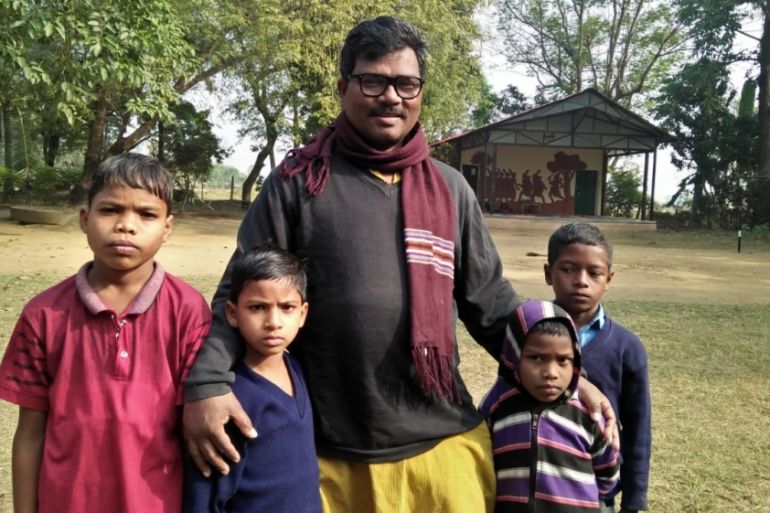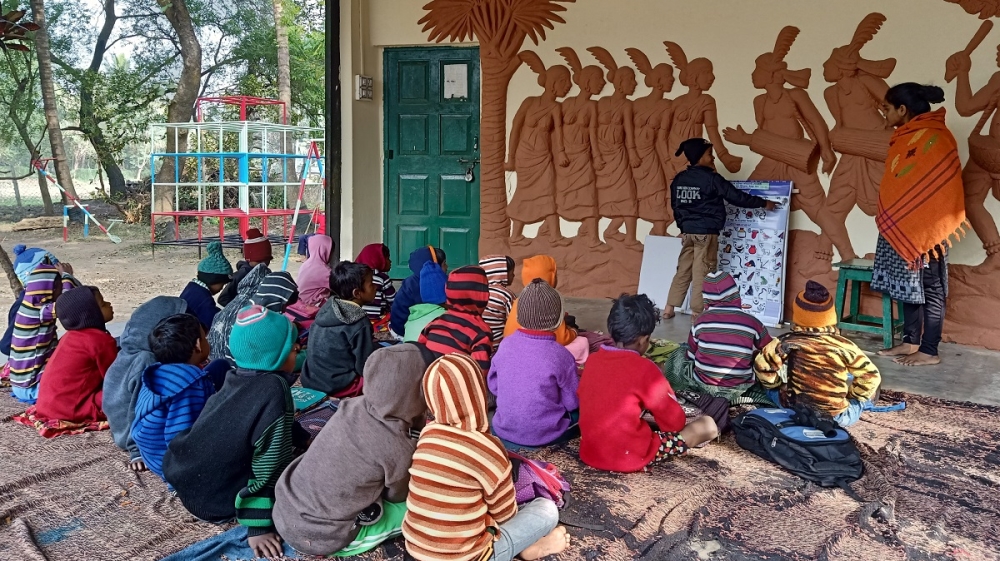The Indian school where Indigenous children are ‘never outsiders’
Boro Baski was the first in his village to receive a formal education and now he is making sure that others do too.

Boro Baski’s goals in life were pretty simple: to complete his education and find a job to support his family.
But Baski, who is now in his late 50s, did not go into the same line of agricultural labour as generations of his family before him.
Keep reading
list of 4 itemsNigeria’s Tunde Onakoya sets global chess record with 60 hour nonstop game
Dozens of pro-Palestinian protesters arrested as Columbia clears encampment
Columbia University leaders face scrutiny over anti-Semitism on campus
He and his parents are members of the Santhal community in the village of Bishnubati in West Bengal, India.
The Santhal community is one of the largest Indigenous groups in South Asia, with 7.4 million members worldwide and an estimated four million in the Indian states of Jharkhand, West Bengal, Bihar and Odisha. Many can also be found in Assam.
Its members mostly follow the Sarna religion, worshipping nature and ancestral spirits, although some are now Christian or Hindu. While Baksi and his father, like most of their community, followed the Sarna religion, his mother was Christian.
In 1977, one of his mother’s brothers, a Christian teacher, persuaded Baski‘s parents to send him to a missionary boarding school 50km (30 miles) away, and offered to pay the fees.
He was not only the first member of his family to experience a formal education, he was also the first from his village.
He was also the first to be given a formal birth date. The people of his village recall dates of birth using the seasons and major natural occurrences. His parents, for example, remember his date of birth as “the year that had great floods”. It was only in school that the date of April 4, 1968, was assigned as his birth date – he will never know the actual date.

A language barrier
During the 11 years he attended boarding school, Baski returned to his village for summer and winter breaks but increasingly found its more traditional way of life uncomfortable. There were no ceiling fans or bright lights like they had at boarding school, no concrete floors, no tables or chairs to sit on, and no friends to communicate with in his new-found language, Bengali.
He felt distant from his peers in the village. “We did not, any longer, have common topics to discuss, nor common interests,” Baski remembers.
He experienced the same problem – in reverse – when he was at school. There, he longed to express himself in his mother tongue, to share stories he had heard from his elders and even to break into songs and dances from his community.
Baski came to understand that a major factor dividing tribal communities from the rest of India was the difficulty children from these communities face when it comes to accessing formal schooling, partly as a result of the language barrier. The Santhal community’s first language is Santhali but in mainstream Indian schools, lessons are taught in Bengali, Hindi or English.
“If you put a Santhal and Bengali boy together in a class, the former will obviously find it difficult to compete because he has the disadvantage of not knowing well the language of instruction,” Baski explains.
“Everyone wants to learn but the problem is atmosphere, the medium of teaching and the method of teaching, besides the facts of economics. It is the reason why tribal children find it difficult to integrate with the mainstream.”
Another factor is the cost of schooling. According to a 2015 report by the Indian Ministry of Human Resource Development, the annual secondary school drop-out rate among Indigenous children in India is just above 40 percent compared with the national average of about 25 percent. The ministry lists “economic” issues as the biggest reason for the dropouts – families just cannot afford to keep their children in school.
Bridging worlds
One evening, when Baski was 18, a chance encounter in the muddy, half-lit railway station in Prantik (a stop on the line to Kolkata), 6km (4 miles) from his village, gave him with the key to bridging his two worlds.
That evening, Baski spotted another local boy, Sona Murmu, travelling with German researcher Martin Kampchen. “I was intrigued to see a white man with a boy who looked like a local Santhal,” Baski remembers. “So I offered to help them board the train.”
Kampchen had come to the local Viswa-Bharati University in 1979 and had studied the Indigenous communities in surrounding West Bengali villages. He was particularly interested in discovering why so many children were dropping out of secondary school and wanted to devise a way to help them continue their studies.
Now, he was helping Sona, the only boy from his village to have completed his secondary education, to teach what he had learned to other local children during evening coaching lessons, often conducted under a tree.
The philosophy behind Kampchen’s method was simple: children within Indigenous communities who had received an education would teach those who had not or who were struggling with their schoolwork, to keep them from dropping out.
Six months after this fateful meeting, Kampchen visited Bishnubati and persuaded Baski to start the practice there. And so his life’s work of bringing education to the children of his community began, with coaching children who were just starting school to help them cope better with the syllabus.

‘Development from within’
To facilitate the evening coaching classes, Baski and Sona, together with Kampchen, founded the non-governmental organisation (NGO) Ghosaldanga Adibasi Seva Sangha (GASS), named after the village Sona comes from.
“Our idea of development is based on a very old idea taken up by many great minds such as Mahatma Gandhi and [the poet] Rabindranath Tagore,” Baski explains. “It is about development from within. Development through the strength of the community’s own.”
In 1996, the NGO went one step further, opening a day school – the Rolf Schoemb Vidyashram (RSV) – close to the villages of Bishnubati and Ghosaldanga (Vidyashram means the “house of learning”).
The school, which offers free education, also provides hot meals to encourage poor parents to send their children. Its ethos is one of community, with programmes devised and implemented by members of the community rather than by outsiders who might not be familiar with the strengths of and issues faced by local people.
The standard provision of blanket-style education, imposed by the Indian government, has often been criticised as unsuitable for Indigenous communities.
But now this more needs-focused form of schooling has started to spread, with about 500 such schools across India.
Known as “Ashram” schools, they are often residential, with pupils and teachers living on the campus.
The Rolf Schoemb school, named after the German astrophysicist who left a legacy in his will for this purpose, currently has 146 pupils and is funded by charitable donations but has books and study materials provided by the government. It takes students who live nearby in classes between kindergarten and Year 4.
We do not sell aspirations. What we are trying to do is help them identify their talent, through education as well as through various activities such as farming, art and music.
Children start off learning in their own language before progressing to Bengali and, in later years, English. To help them learn the alphabets of new languages, the school uses words in the children’s mother tongue to explain them.
The multi-faceted approach of the school, which places equal emphasis on extracurricular activities, such as art, clay modelling, music, farming and gardening, also attracts parents and children to the school, where they attend classes until noon.
For children pursuing higher education in more formal schools beyond Year 4, GASS provides hostel accommodation within its grounds to enable them to remain in a learning environment. The schools they attend are usually a few kilometres away and they travel by public transport together. The hostels currently house 40 boys and girls.
The community’s needs are central to the aims of the school. “We do not sell aspirations,” Baski explains. “What we are trying to do is help them identify their talent, through education as well as through various activities such as farming, art and music.”
‘I never felt like an outsider’
This approach has found favour with parents and pupils. Pradeep Hansda, 17, who studied at RSV until Year 4 and now resides in the hostel for older students studying elsewhere, says: “I never felt like an outsider there. It always felt like being around your own people.”
Hansda’s parents are farmers but he wants to be a teacher. He will sit his Year 10 exams this year.
For Pansuri Baske, giving her niece a better life meant providing her with an education. She is encouraged when her niece, who is a Year 4 student at RSV, says she wants to go to school, even during holidays.
“My niece never wants to be absent from school. She loves singing and reciting poetry. The best thing about RSV is their informal way of teaching and the fact that these children learn in different languages, including our own,” she adds. Baske hopes her niece can realise her dream of becoming a nurse.
Schooling takes a practical approach here. Even though the school and the villages of Bishnubati and Ghosaldanga lie within 10km (6 miles) of the homes of two Nobel laureates – Bengali writer and poet Rabindranath Tagore and economist Amartya Sen – they are emphatically not held up as the children’s only local role models.
“They [the children] have aspirations but they will work within their means,” Baski explains. “Some people want to be carpenters, tailors or teachers, or to pursue hotel management, and we help them do it.”

Keeping the faith
Baski, who holds a doctorate in education and a master’s in social work from Viswa Bharati University, says he is happy being an educator. He has become a strong voice of the community not just in India but elsewhere, writing articles and books, and representing his community at conferences.
He is also dedicated to preserving Santhal cultural heritage.
In 2007, GASS built a small museum in Bishnubati to preserve some 100 artefacts, including weapons, musical instruments, photographs and medicinal herbs, that represent the community. Most of the artefacts were donated by tribal elders from across the states of West Bengal, Jharkhand and Odisha. They include silver jewellery once owned by Baski’s mother.
“The idea is to tell the world that we are not just happy-go-lucky people, as perpetuated by the mainstream media,” he says. “We have held expertise in hunting and fishing tools, in sophisticated music and medicines, for generations. It is just that this expertise was never spoken about.”
One of the pictures adorning the walls of the museum is of his wedding to his Catholic wife, a teacher, in a ceremony that marked both Santhal and Christian traditions – a symbol of the amalgamation of two distinct identities.
Baski met his wife, Asha Baski, when he visited the school she was teaching at in Kolkata to talk about his initiative. His family lives 100km away in Bandel, where Asha works, while Baski stays on in his village, overseeing the school.
His oldest daughter, Ipil, is studying English literature at Jadavpur University in Kolkata, while his younger daughter, Aril, attends school in Bandel.
“I don’t yearn for luxuries any more,” he says, as the winter sun peeps through the sonajhuri and acacia trees in the school compound. “What I do yearn for is for our children to be proud of their cultural heritage and preserve the traditions we hold so close.”
As if to demonstrate, as the sun begins to set, Baski takes his flute from his office drawer and plays a traditional tune.